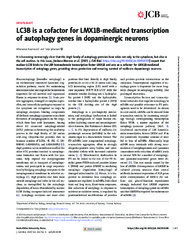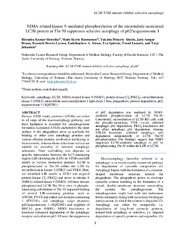Blar i forfatter Det helsevitenskapelige fakultet "Johansen, Terje"
-
Kenny mediates selective autophagic degradation of the IKK complex to control innate immune responses
Tusco, Radu; Jacomin, Anne-Claire; Jain, Ashish; Penman, Bridget S.; Larsen, Kenneth Bowitz; Johansen, Terje; Nezis, Ioannis P. (Journal article; Tidsskriftartikkel; Peer reviewed, 2017-11-02)Selective autophagy is a catabolic process with which cellular material is specifically targeted for degradation by lysosomes. The function of selective autophagic degradation of self-components in the regulation of innate immunity is still unclear. Here we show that Drosophila Kenny, the homolog of mammalian IKKγ, is a selective autophagy receptor that mediates the degradation of the IκB kinase ... -
LC3B is a cofactor for LMX1B-mediated transcription of autophagy genes in dopaminergic neurons
Kournoutis, Athanasios; Johansen, Terje (Journal article; Tidsskriftartikkel, 2023-04-10)It is becoming increasingly clear that the Atg8 family of autophagy proteins have roles not only in the cytoplasm, but also in the cell nucleus. In this issue, Jimenez-Moreno et al. (2023. J. Cell Biol. <a href=https://doi.org/10.1083/jcb.201910133>https://doi.org/10.1083/jcb.201910133</a>) report that nuclear LC3B binds to the LIM homeodomain transcription factor LMX1B and acts as a cofactor for ... -
Mammalian Atg8 proteins regulate lysosome and autolysosome biogenesis through SNAREs
Gu, Yuexi; Abudu, Yakubu Princely; Kumar, Suresh; Bissa, Bhawana; Choi, Seong Won; Jia, Jingyue; Lazarou, Michael; Eskelinen, Eeva-Liisa; Johansen, Terje; Deretic, Vojo (Journal article; Tidsskriftartikkel; Peer reviewed, 2019-10-18)Mammalian homologs of yeast Atg8 protein (mAtg8s) are important in autophagy, but their exact mode of action remains ill‐defined. Syntaxin 17 (Stx17), a SNARE with major roles in autophagy, was recently shown to bind mAtg8s. Here, we identified LC3‐interacting regions (LIRs) in several SNAREs that broaden the landscape of the mAtg8‐SNARE interactions. We found that Syntaxin 16 (Stx16) and its cognate ... -
Mechanisms of Selective Autophagy
Lamark, Trond; Johansen, Terje (Journal article; Tidsskriftartikkel; Peer reviewed, 2021-06-21)Selective autophagy is the lysosomal degradation of specific intracellular components sequestered into autophagosomes, late endosomes, or lysosomes through the activity of selective autophagy receptors (SARs). SARs interact with autophagy-related (ATG)8 family proteins via sequence motifs called LC3-interacting region (LIR) motifs in vertebrates and Atg8-interacting motifs (AIMs) in yeast and plants. ... -
Members of the autophagy class III phosphatidylinositol 3-kinase complex I interact with GABARAP and GABARAPL1 via LIR motifs
Birgisdottir, Åsa Birna; Mouilleron, Stephane; Bhujabal, Zambarlal; Wirth, Martina; Sjøttem, Eva; Evjen, Gry; Zhang, Wenxin; Lee, Rebecca; O'Reilly, Nicola; Tooze, Sharon A; Lamark, Trond; Johansen, Terje (Journal article; Tidsskriftartikkel; Peer reviewed, 2019-03-04)Autophagosome formation depends on a carefully orchestrated interplay between membrane-associated protein complexes. Initiation of macroautophagy/autophagy is mediated by the ULK1 (unc-51 like autophagy activating kinase 1) protein kinase complex and the autophagy-specific class III phosphatidylinositol 3-kinase complex I (PtdIns3K-C1). The latter contains PIK3C3/VPS34, PIK3R4/VPS15, BECN1/Beclin 1 ... -
Membrane Atg8ylation, stress granule formation, and MTOR regulation during lysosomal damage
Jia, Jingyue; Wang, Fulong; Bhujabal, Zambarlal Babanrao; Peters, Ryan; Mudd, Michal; Duque, Thabata; Allers, Lee; Javed, Ruheena; Salemi, Michelle; Behrends, Christian; Phinney, Brett; Johansen, Terje; Deretic, Vojo (Journal article; Tidsskriftartikkel; Peer reviewed, 2022-11-29)The functions of mammalian Atg8 proteins (mATG8s) expand beyond canonical autophagy and include processes collectively referred to as Atg8ylation. Global modulation of protein synthesis under stress conditions is governed by MTOR and liquid-liquid phase separated condensates containing ribonucleoprotein particles known as stress granules (SGs). We report that lysosomal damage induces SGs acting as ... -
Molecular determinants regulating selective binding of autophagy adapters and receptors to ATG8 proteins
Wirth, Martina; Zhang, Wenxin; Razi, Minoo; Nyoni, Lynet; Joshi, Dhira; O'Reilly, Nicola; Johansen, Terje; Tooze, Sharon; Mouilleron, Stephane (Journal article; Tidsskriftartikkel; Peer reviewed, 2019-05-03)Autophagy is an essential recycling and quality control pathway. Mammalian ATG8 proteins drive autophagosome formation and selective removal of protein aggregates and organelles by recruiting autophagy receptors and adaptors that contain a LC3-interacting region (LIR) motif. LIR motifs can be highly selective for ATG8 subfamily proteins (LC3s/GABARAPs), however the molecular determinants regulating ... -
NBR1: The archetypal selective autophagy receptor
Rasmussen, Nikoline Lander; Kournoutis, Athanasios; Lamark, Trond; Johansen, Terje (Journal article; Tidsskriftartikkel; Peer reviewed, 2022-10-18)NBR1 was discovered as an autophagy receptor not long after the first described vertebrate autophagy receptor p62/SQSTM1. Since then, p62 has currently been mentioned in >10,000 papers on PubMed, while NBR1 is mentioned in <350 papers. Nonetheless, evolutionary analysis reveals that NBR1, and likely also selective autophagy, was present already in the last eukaryotic common ancestor (LECA), while ... -
NIMA-related kinase 9–mediated phosphorylation of the microtubule-associated LC3B protein at Thr-50 suppresses selective autophagy of p62/sequestosome 1
Shrestha, Birendra Kumar; Rasmussen, Mads Skytte; Abudu, Yakubu Princely; Bruun, Jack-Ansgar; Larsen, Kenneth Bowitz; Alemu, Endalkachew Ashenafi; Sjøttem, Eva; Lamark, Trond; Johansen, Terje (Journal article; Tidsskriftartikkel; Peer reviewed, 2019-12-19)Human ATG8 family proteins (ATG8s) are active in all steps of the macroautophagy pathway, and their lipidation is essential for autophagosome formation. Lipidated ATG8s anchored to the outer surface of the phagophore serve as scaffolds for binding of other core autophagy proteins and various effector proteins involved in trafficking or fusion events, whereas those at the inner surface are needed for ... -
NIPSNAP1 and NIPSNAP2 Act as “Eat Me” Signals for Mitophagy
Abudu, Yakubu Princely; Pankiv, Serhiy; Mathai, Benan John; Lystad, Alf Håkon; Bindesbøll, Christian; Brenne, Hanne Britt; Ng, Matthew Yoke Wui; Thiede, Bernd; Yamamoto, Ai; Nthiga, Thaddaeus Mutugi; Lamark, Trond; Esguerra, Camila Vicencio; Johansen, Terje; Simonsen, Anne (Journal article; Tidsskriftartikkel; Peer reviewed, 2019-04-11)The clearance of damaged or dysfunctional mitochondria by selective autophagy (mitophagy) is important for cellular homeostasis and prevention of disease. Our understanding of the mitochondrial signals that trigger their recognition and targeting by mitophagy is limited. Here, we show that the mitochondrial matrix proteins 4-Nitrophenylphosphatase domain and non-neuronal SNAP25-like protein homolog ... -
Nrf2 and SQSTM1/p62 jointly contribute to mesenchymal transition and invasion in glioblastoma
Pölonen, Petri; Jawahar Deen, Ashik; Leinonen, Hanna M.; Jyrkkänen, Henna-Kaisa; Kuosmanen, Suvi; Mononen, Mimmi; Jain, Ashish; Tuomainen, Tomi; Pasonen-Seppänen, Sanna; Hartikainen, Jaana M.; Mannermaa, Arto; Nykter, Matti; Tavi, Pasi; Johansen, Terje; Heinäniemi, Merja; Levonen, Anna-Liisa (Journal article; Tidsskriftartikkel; Peer reviewed, 2019-08-23)Accumulating evidence suggests that constitutively active Nrf2 has a pivotal role in cancer as it induces pro-survival genes that promote cancer cell proliferation and chemoresistance. The mechanisms of Nrf2 dysregulation and functions in cancer have not been fully characterized. Here, we jointly analyzed the Broad-Novartis Cancer Cell Line Encyclopedia (CCLE) and the Cancer Genome Atlas (TCGA) ... -
p62 and NDP52 Proteins Target Intracytosolic Shigella and Listeria to Different Autophagy Pathways
Mostowy, Serge; Sancho-Shimizu, Vanessa; Hamon, Mélanie Anne; Simeone, Roxane; Brosch, Roland; Johansen, Terje; Cossart, Pascale (Journal article; Tidsskriftartikkel; Peer reviewed, 2011-06-06)Autophagy is an important mechanism of innate immune defense. We have recently shown that autophagy components are recruited with septins, a new and increasingly characterized cytoskeleton component, to intracytosolic Shigella that have started to polymerize actin. On the other hand, intracytosolic Listeria avoids autophagy recognition by expressing ActA, a bacterial effector required for actin ... -
P62/sequestosome-1, autophagy-related gene 8, and autophagy in Drosophila are regulated by nuclear factor erythroid 2-related factor 2(NRF2), independent of transcription factor TFEB
Jain, Ashish; Rusten, Tor Erik; Katheder, Nadja Sandra; Elvenes, Julianne; Bruun, Jack-Ansgar; Sjøttem, Eva; Lamark, Trond; Johansen, Terje (Journal article; Tidsskriftartikkel; Peer reviewed, 2015-04-30)The selective autophagy receptor p62/sequestosome 1 (SQSTM1) interacts directly with LC3 and is involved in oxidative stress signaling in two ways in mammals. First, p62 is transcriptionally induced upon oxidative stress by the NF-E2-related factor 2 (NRF2) by direct binding to an antioxidant response element in the p62 promoter. Second, p62 accumulation, occurring when autophagy is impaired, leads ... -
Pax6 Represses Androgen Receptor-Mediated Transactivation by Inhibiting Recruitment of the Coactivator SPBP
Elvenes, Julianne; Thomassen, Ernst Ivan; Johnsen, Sylvia Sagen; Kaino, Katrine; Sjøttem, Eva; Johansen, Terje (Journal article; Tidsskriftartikkel; Peer reviewed, 2011)The androgen receptor (AR) has a central role in development and maintenance of the male reproductive system and in the etiology of prostate cancer. The transcription factor Pax6 has recently been reported to act as a repressor of AR and to be hypermethylated in prostate cancer cells. SPBP is a transcriptional regulator that previously has been shown to enhance the activity of Pax6. In this study ... -
Phosphorylation of Syntaxin 17 by TBK1 Controls Autophagy Initiation
Kumar, Suresh; Gu, Yuexi; Abudu, Yakubu Princely; Bruun, Jack-Ansgar; Jain, Ashish; Farzam, Farzin; Mudd, Michal H.; Anonsen, Jan Haug; Rusten, Tor Erik; Kasof, Gary; Ktistakis, Nicholas; Lidke, Keith A; Johansen, Terje; Deretic, Vojo (Journal article; Tidsskriftartikkel; Peer reviewed, 2019-02-28)Syntaxin 17 (Stx17) has been implicated in autophagosome-lysosome fusion. Here, we report that Stx17 functions in assembly of protein complexes during autophagy initiation. Stx17 is phosphorylated by TBK1 whereby phospho-Stx17 controls the formation of the ATG13<sup>+</sup>FIP200<sup>+</sup> mammalian pre-autophagosomal structure (mPAS) in response to induction of autophagy. TBK1 phosphorylates Stx17 ... -
Phosphorylation of the LIR Domain of SCOC Modulates ATG8 Binding Affinity and Specificity
Wirth, Martina; Mouilleron, Stephane; Zhang, Wenxin; Abudu, Yakubu Princely; Jain, Ashish; Olsvik, Hallvard Lauritz; Bruun, Jack-Ansgar; Razi, Minoo; Jefferies, Harold B.J.; Lee, Rebecca; Joshi, Dhira; O'Reilly, Nicola; Johansen, Terje; Tooze, Sharon A (Journal article; Tidsskriftartikkel; Peer reviewed, 2021-04-24)<p>Autophagy is a highly conserved degradative pathway, essential for cellular homeostasis and implicated in diseases including cancer and neurodegeneration. Autophagy-related 8 (ATG8) proteins play a central role in autophagosome formation and selective delivery of cytoplasmic cargo to lysosomes by recruiting autophagy adaptors and receptors. The LC3-interacting region (LIR) docking site (LDS) of ... -
A Phylogenetic Study of SPBP and RAI1: Evolutionary Conservation of Chromatin Binding Modules
Darvekar, Sagar; Rekdal, Cecilie; Johansen, Terje; Sjøttem, Eva (Journal article; Tidsskriftartikkel; Peer reviewed, 2013)Our genome is assembled into and array of highly dynamic nucleosome structures allowing spatial and temporal access to DNA. The nucleosomes are subject to a wide array of post-translational modifications, altering the DNAhistone interaction and serving as docking sites for proteins exhibiting effector or “reader” modules. The nuclear proteins SPBP and RAI1 are composed of several putative “reader” ... -
Regulation of Expression of Autophagy Genes by Atg8a-Interacting Partners Sequoia, YL-1, and Sir2 in Drosophila
Jacomin, Anne-Claire; Petridi, Stavroula; Di Monaco, Marisa; Bhujabal, Zambarlal; Jain, Ashish; Mulakkal, Nitha C.; Palara, Anthimi; Powell, Emma L.; Chung, Bonita; Zampronio, Cleidiane; Jones, Alexandra; Cameron, Alexander; Johansen, Terje; Nezis, Ioannis P. (Journal article; Tidsskriftartikkel; Peer reviewed, 2020-05-26)Autophagy is the degradation of cytoplasmic material through the lysosomal pathway. One of the most studied autophagy-related proteins is LC3. Despite growing evidence that LC3 is enriched in the nucleus, its nuclear role is poorly understood. Here, we show that <i>Drosophila</i> Atg8a protein, homologous to mammalian LC3, interacts with the transcription factor Sequoia in a LIR motif-dependent ... -
Regulation of Golgi turnover by CALCOCO1-mediated selective autophagy
Nthiga, Thaddaeus Mutugi; Shrestha, Birendra Kumar; Bruun, Jack-Ansgar; Larsen, Kenneth Bowitz; Lamark, Trond; Johansen, Terje (Journal article; Tidsskriftartikkel; Peer reviewed, 2021-04-19)The Golgi complex is essential for the processing, sorting, and trafficking of newly synthesized proteins and lipids. Golgi turnover is regulated to meet different cellular physiological demands. The role of autophagy in the turnover of Golgi, however, has not been clarified. Here we show that CALCOCO1 binds the Golgi-resident palmitoyltransferase ZDHHC17 to facilitate Golgi degradation by autophagy ... -
SAMM50 acts with p62 in piecemeal basal- and OXPHOS-induced mitophagy of SAM and MICOS components
Abudu, Yakubu Princely; Shrestha, Birendra Kumar; Zhang, Wenxin; Palara, Anthimi; Brenne, Hanne Britt; Larsen, Kenneth Bowitz; Wolfson, Deanna; Dumitriu, Gianina; Øie, Cristina Ionica; Ahluwalia, Balpreet Singh; Levy, Gahl; Behrends, Christian; Tooze, Sharon A; Mouilleron, Stephane; Lamark, Trond; Johansen, Terje (Journal article; Tidsskriftartikkel; Peer reviewed, 2021-05-26)Mitophagy is the degradation of surplus or damaged mitochondria by autophagy. In addition to programmed and stress-induced mitophagy, basal mitophagy processes exert organelle quality control. Here, we show that the sorting and assembly machinery (SAM) complex protein SAMM50 interacts directly with ATG8 family proteins and p62/SQSTM1 to act as a receptor for a basal mitophagy of components of the ...


 English
English norsk
norsk


















